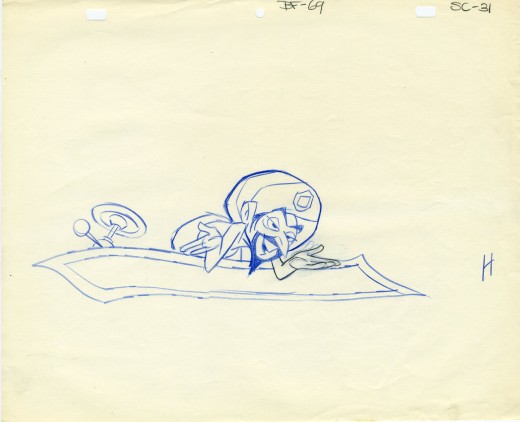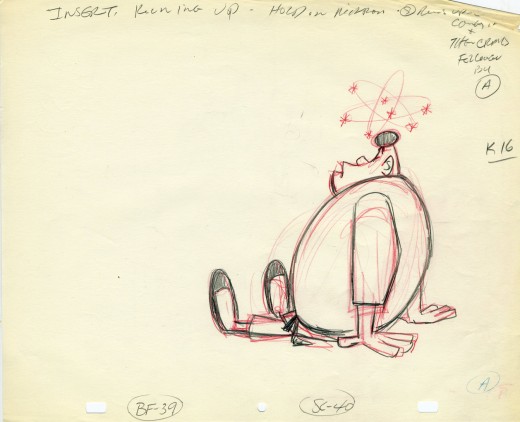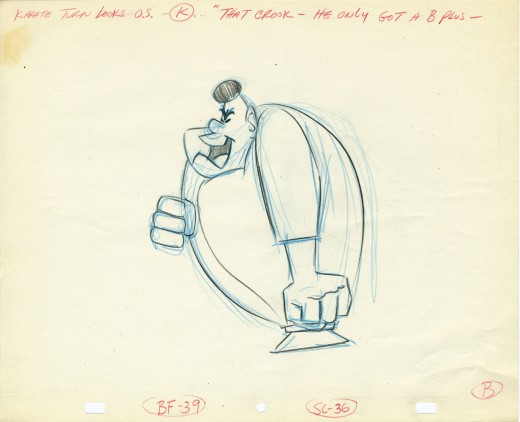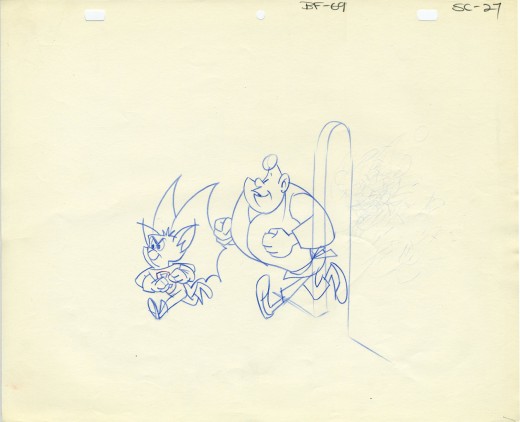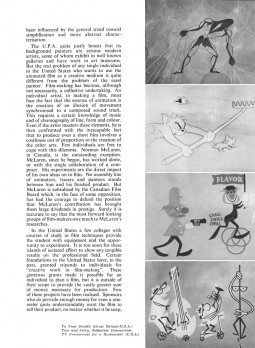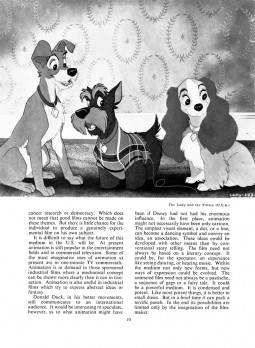Monthly ArchiveJuly 2006
Animation Artifacts &Daily post 31 Jul 2006 09:41 am
Building & Building
Hans Perk has posted the drafts to Building A Building on his site, A Film LA. It brought an immediate memory back to me.
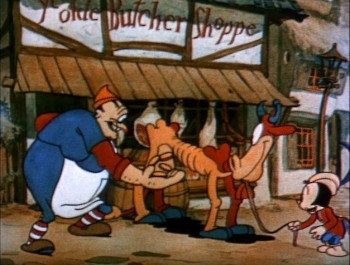 When I was 12 I got my first 8mm projector. This was before the days of dvd, before the days of vhs. I rigged the projector to project one frame at a time so I could study every frame of the films I was able to buy. Ub Iwerks’ film, Jack and the Beanstalk was probably the first of the films I watched this way. One frame at a time. As a matter of fact, I traced the characters off the projected screen. (Little did I realize it was Grim Natwick’s anima- tion that I was studying so ardently. He wasn’t enormously impressed, years later, when I mentioned this to him in an interview. Regardless, his influence on me was strong.)
When I was 12 I got my first 8mm projector. This was before the days of dvd, before the days of vhs. I rigged the projector to project one frame at a time so I could study every frame of the films I was able to buy. Ub Iwerks’ film, Jack and the Beanstalk was probably the first of the films I watched this way. One frame at a time. As a matter of fact, I traced the characters off the projected screen. (Little did I realize it was Grim Natwick’s anima- tion that I was studying so ardently. He wasn’t enormously impressed, years later, when I mentioned this to him in an interview. Regardless, his influence on me was strong.)
Building A Building was another of these I studied; it’s a film I loved the second I saw it – even in that silent world of 8mm.
There were a lot of films I went through, but only a few I treasured (the 8mm library wasn’t a great one.) I was a big Iwerks fan, and his films were accessible back then. Aladdin’s Lamp, Sinbad the Sailor, and a Willie Whopper film; What Makes Daffy Duck gave me a real appreciation for Art Davis’ direction; Little Lulu’s Bored of Education gave me Bill Tytla’s direction; a couple of Heckle & Jeckles offered the treat of Jim Tyer’s animation.
It was a bric-a-brac animation education, but it colored my thoughts. My early influences became Bill Tytla, Grim Natwick, Art Davis and Jim Tyer. A feast for someone in love with animation and the graphic arts.
- Today any kid can watch anything they want. It’s all available. After seeing Lady and the Tramp in 1955, I wasn’t able to see it again till 1962. The same is true of all of those Disney classics – every 7 years, and that was it. Unless there was a Disneyland TV special compiling clips.
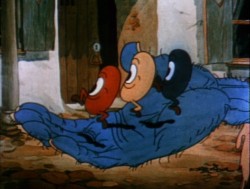 Today, any child can watch any of the features, then make frame grabs from the film. They can put a section up on YouTube if they want. It’s a whole new world, and there seems to be less to see, somehow. Is it all appreciated? Does any of it get to be special?
Today, any child can watch any of the features, then make frame grabs from the film. They can put a section up on YouTube if they want. It’s a whole new world, and there seems to be less to see, somehow. Is it all appreciated? Does any of it get to be special?
I wonder if in being forced fed that “specialness†, I was made to appreciate something in any greater way. Does a child, today, desperate to go into animation, have the same influences? Are they better and greater since the film choices are so much better? I’d love to know if the overabundance of seed thrown by the wayside is equal to the paltry few doled out. I guess it’s a question I can’t answer.
- 4 animated features are currently in theaters. Here are the box office receipts for the past weekend:
Monster House grossed $11,500,000 with an average daily per-theater take of $1079.
The Ant Bully grossed $8,145,000 with an average daily per-theater take of $890.
Cars grossed $2,467,000 with an average daily per-theater take of $1500.
A Scanner Darkly grossed $454,000 with an average daily per-theater take of $1726.
Next weekend Barnyard enters the fray. My favorite figure is for A Scanner Darkly which makes the highest per screen average. Maybe some intelligent entrepeneur can try an adult animated feature with an other technique rather than rotoscoping. Imagine Waking Life with a drawn, not rotoscoped, style. (It wouldn’t have worked with Scanner.)
Animation &Daily post 30 Jul 2006 09:43 am
DNA
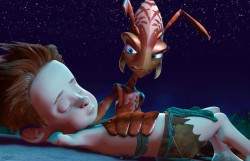 Jim Hill Media has given a lot of space to a three part article on The Ant Bully. Somehow I haven’t had the patience to get into this film. It was done by the Jimmy Neutron/Olive the Reideer people, DNA Productions.
Jim Hill Media has given a lot of space to a three part article on The Ant Bully. Somehow I haven’t had the patience to get into this film. It was done by the Jimmy Neutron/Olive the Reideer people, DNA Productions.
The pluses for this show come with Tom Hanks, the producer. He has a good nose for a script and probably pulled the most from the material. The cast includes Meryl Streep, whose voice is probably the only element that would get me to watch.
The minuses are in the graphics. Everything I’ve seen of this film is ugly. The design is just not good. These look like ants out of ANTZ, and they didn’t look like ants. I’ve also not seen anything by DNA Productions that’s gotten me to sit through an entire film. Their art direction usually seems so flat to me.
I know; I’m unfair. I should be forced to at least see it before I judge. I think the problem is that I don’t have the patience for these talk down to/soup up the kids films anymore. Shouldn’t there be some room for something other than Monster Houses, and Ant Bullies? I just saw an ad for Barnyard – another one. They’re all looking alike to me: little rubbery dolls that float around little rubbery settings. Cars had great graphics, but the script was a retread, and the soundtrack was screaming LOUD.
Where is the gentle side? The one we saw in Dumbo and Pinocchio and Lady & The Tramp. Iron Giant had it; so did Toy Story. The first half of The Incredibles did, too.
You know, I’m even starting to bore myself; ignore this post and come back tomorrow.
- Today’s NYTimes includes an extensive article about Tom Hanks and his production company, Playtone.
Art Art &Daily post 29 Jul 2006 07:34 am
Bob Ross meet Jon Gnagy
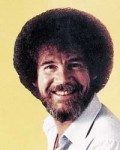 - For the Bob Ross fans out there who miss the afro-haired painting instructor’s PBS program, a number of clips from the show have shown up on YouTube. Quiet entertainment for the internet on a rainy day.
- For the Bob Ross fans out there who miss the afro-haired painting instructor’s PBS program, a number of clips from the show have shown up on YouTube. Quiet entertainment for the internet on a rainy day.
When I was young, Jon Gnagy was the on-air art instructor. His paintings might have been a little better than Bob Ross’, or maybe it’s my memory that makes them better. Just like Bob Ross, Jon Gnagy had his own line of supplies, instruction manuals and kits designed to help the beginning artist.
The first thing I’d ever won was 3rd prize in a cub scout Halloween dress-up contest. (I was a robot.) The prize was a choice of whatever was left after winners 1 & 2 had chosen. Of course, I was the only one in the pack that wanted the Jon Gnagy kit, so that was my #1 prize. It contained a lot of newsprint paper, conte crayons, charcoal pencil, kneaded eraser and a book.
I’m not sure it helped very much. Rather than use up all the art supplies, I treated the kit with delicacy. To keep it away from my four other siblings, I hid the box of materials above a wardrobe in the basement. I pretty much forgot about it after that, and discovered years later that the supplies had withered under the heat of the pipe just over the wardrobe. The box lay against it, and all the newprint turned brown and dried out.
Needless to say, I knew I didn’t need those chalks and paper to draw. I seemed always to be doing it anyway.
- The NY Times offers an audio slide show from the director of Monster House, Gil Kenan, about the development and creation of the house, itself.
Animation Artifacts 28 Jul 2006 07:32 am
Batfink
- I have a large number of layout drawings from some of the Batfink episodes. I have these listed as being drawn by Dave Tendlar, but I won’t guarantee that. Some of the drawings are good. I believe this episode was called “The Thief From Baghdad” done in 1967.
The layouts don’t give too many poses for any setup, however there weren’t too many poses in any of the films. So, they’re probably all here. Undoubtedly, this show would have been done in Flash had it been done today, and it probably would have suffered. Unfortunately, the quality wasn’t very good, so it really wouldn’t have mattered.
Years before the racism of Letterman‘s Spellbinder, this show went farther. Arab and Japanese stereotypes didn’t seem to matter back in the 60′s when political correctness didn’t exist.
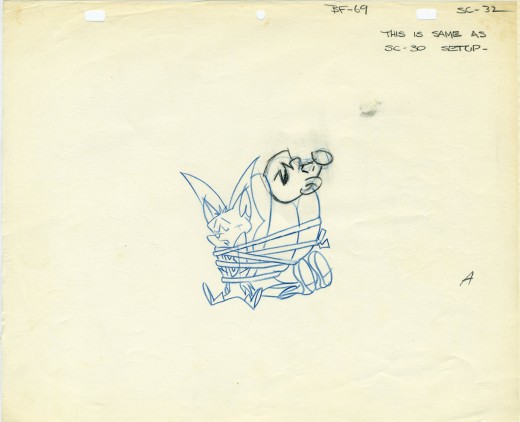
(Click on any image to enlarge.)
Commentary &Daily post 27 Jul 2006 07:29 am
Scanning Scanning Scanning
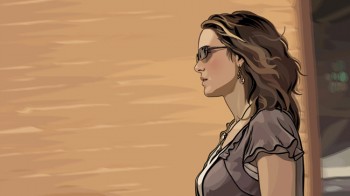 – I promise, this is my last post about
– I promise, this is my last post about
A Scanner Darkly. Please read this review by auteurist critic, Andrew Sarris. He has only admitted that he knows nothing about animation and only reviews them as films per se. That’s the way I like it. This is an excellent, perceptive and accurate reading of the film. Sarris still stands as one our finest critics; one with history, depth, intelligence, and a superior knowledge of film. And since I often agree with him, I like his reviews.
David Byrne also comments on the film & the rotoscoping on his site.
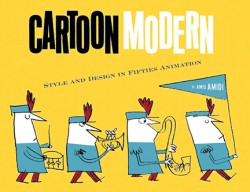 – If you haven’t been to Amid Amidi’s Cartoon Modern in a while, it’s time to take another look. He gives us another view of Rod Scribner; the UPA side.
– If you haven’t been to Amid Amidi’s Cartoon Modern in a while, it’s time to take another look. He gives us another view of Rod Scribner; the UPA side.
It’s nice to see this work and be reminded that the animator had a lot more depth than we’ve seen, even at Warners.
I can’t wait to get my hands on this book of Amid’s.
-Another site worth spending some time viewing is Daniel Thomas MacInnes‘ Conversations with Ghibli. This site is wholly dedicated to Ghibli films and actually features a number of complete films on the site. Ghibli’s Umi Ga Kikoeru (I Can Hear The Sea) is posted currently. Horus – The Great Adventure of Horus, Prince of the Sun was posted in its entirety earlier in July.
There’s a lot of articulate analysis on this site for fans of anime and Ghibli.
Books 26 Jul 2006 07:23 am
2 Novels about Walt
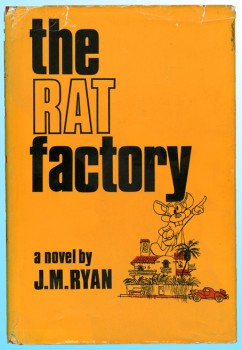
- Back in the 1970′s there was some conversation heard in animation circles about a novel, The Rat Factory, by JD Ryan, the pseudonym for a former Disney inbetweener named Jim McDermott. The novel, it was said, was about the dark side of working for Walt Disney. How a lowly, underpaid employee could get caught up in borrowing from the studio and not being able to ever get his head above water again. The myth about this book continued over my early years in animation.
Since I collected books about animation, and since my interest was obviously piqued, I started to search for this book. However, it was just not a book that could be found. A number of outfits that searched for hard-to-get books, couldn’t locate a copy. I gave up.
That changed when ebay entered the picture, and sure enough, I found and bought the book.
The hype was too much, and the book didn’t live up to the advance notices by people who, supposedly, read it. Ward Ezekial Sampson, is a thinly disguised Disney, the creator of Ricky Rat, Dizzy Duck and Dirty Dog. (None of those names are half as believable or creative as Mickey, Donald or Goofy.) The lead, Ambrose, gets the inbetweening job and is involved in the studio, but a lot of time is spent with his unlikely friends: Darlene Barff – a majorette; his landlady – who flaunts her nudism and tries to seduce him; Ezzy – a cultist who worships, trees and lizards. Not enough time is spent in the studio and the politics therein.
The book by J.M. Ryan, is not very well written, nor is it a great read. One isn’t really convinced that the writer and former illustrator actually was an inbetweener; there are few turns to reveal much that couldn’t have been learned with a good interview or three. In fact, it’s no more realistic than was the material visualized in “The Duck Factory,” the old, short-lived Jim Carrey tv show.
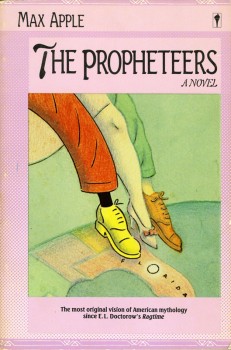 – A much more exciting, enjoyable read is Max Apple‘s novel, The Propheteers. This book is the outgrowth of a long short story by the author, The Oranging of America (available in the short story collection of the same name). It’s such a fun read that I’ve gone through the book at least three times.
– A much more exciting, enjoyable read is Max Apple‘s novel, The Propheteers. This book is the outgrowth of a long short story by the author, The Oranging of America (available in the short story collection of the same name). It’s such a fun read that I’ve gone through the book at least three times.
In Apple’s story, Walt and his older brother, Will (Roy, in real-life), vie for some land in Orlando, Florida. Their competition is Howard Johnson who wants to build Johnsonland, a nature-lover’s Audobon Society version of Disneyland for older folks. The cross country race to buy up the land involves C.W.Post and his Post Cereals in Michigan, and the Birdseyes with their frozen foods. None of it, of course, is reality, and yet all of it is. It’s hilarious.
Here’s a sample. A fake history tells the story of Mickey Mouse, and in the following section Will (i.e. Roy) gives Walt a pep talk:
“In fact, for the cruise over Orlando the Disney brothers made one of their rare changes in itinerary. Usually they did not travel in the same aircraft or even stay at the same hotel. Walt could not leave California without being skeptical about all the past Mickey Mouse business.
“We did the goddamn mouse thing,” he said often, “and that’s enough. How many goddamn mouse things can a man do?”
Will Disney had the personality to complement his brother’s genius. “Walter,” he would say, “once you get people listening to a talking mouse you have got them, brother, by the nuts.” Will called his brother’s creation “Milky Mouse,” because he could milk it for all it was worth.
Years after making it big, Walt still had no confidence. Money in the bank did little to bolster him. Becoming an international celebrity only made him think less of the world. “Sometimes I think, Will, that one of these mornings I’m just going to wake up and find out that it’s all over. The Mouse, Donald, Pluto, Scrooge, Minnie, the nephews, the comic books, the whole drafting department gone like a flushed toilet.”
“Yes,” Will said, “but if that ever happens your shoes and your bed and your house and California and New York will all be gone too. When are you going to realize, Walter, that what we have is a product, the same as cars and food and clothes?
When are you going to stop whining about Mickey and Donald and wake up to the whole damn industry? Did Henry Ford worry that someday people would stop buying the Model T? The hell he did. For twenty years he wouldn’t even give ‘em a second color. Do farmers sit around on their butts not planting seed just in case there’s going to be a drought next summer? And what about the whole damn clothing industry? On just about any day, people can stop buying new duds and make do for a couple of years. That don’t scare the shit out of Seventh Avenue. Hell, no, it just makes people work harder, take bigger risks. It keeps things interesting, Walter, and you and I, brother, we’re in the most interesting business of all.”
Will could always bring him out of the dumps with his little pep talks. He had to remind Walter that they were part of a big, wide, profitable world.
Animation Artifacts 25 Jul 2006 07:33 am
Philip Stapp Writes
I’d like to post another article from that same British Film Academy “Journal. ” on the International Animated Film. This was published in 1956.
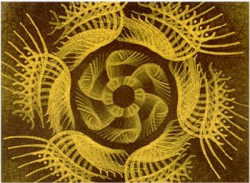 Philip Stapp writes a survey of animation in the United States. It’s an articulate article that I found worth reading. Stapp‘s view of the animation world is a bit high brow, as were many of the UPA supporters of the time. (It seems there were those that didn’t get UPA and those that got only UPA.)
Philip Stapp writes a survey of animation in the United States. It’s an articulate article that I found worth reading. Stapp‘s view of the animation world is a bit high brow, as were many of the UPA supporters of the time. (It seems there were those that didn’t get UPA and those that got only UPA.)
Stapp was an interesting, creative film maker. He has gained much of his fame for the educational films he did for Julien and Sam Bryan‘s International Film Foundation. This was one of the foremost and most diverse educational film producers which had a strong focus on international geography, history and relationships. Philip Stapp did quite a few films for them, and they show a strong sense of design as a way of clearly illustrating their information.
I initially came upon Stapp‘s name when I did one of my first films; it was also for Sam and Julien Bryan. I was treated like an artist and allowed to do whatever I wanted to do. My job was no more than an illustrated map (a long one), but I did a very complicated affair in trying to get a lot across. Sam Bryan lent me a number of Stapp‘s films to view, and I gobbled them up. I’d like to see more written about Philip Stapp in time. As a matter of fact, it’d be nice to see more written about Sam and Julien Bryan.
Here’s the article.
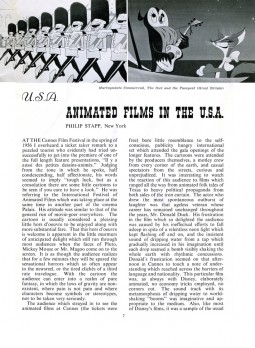 1
1 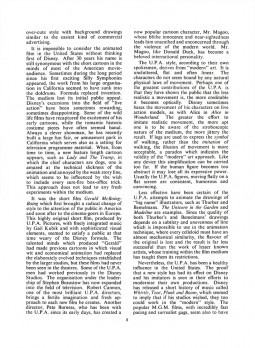 2
2
(Click on any image to enlarge.)
Commentary &SpornFilms &Theater 24 Jul 2006 08:57 am
Mako
 The actor, Mako, died Friday at the age of 72. He was a Japanese born American whose work I first came upon in Robert Wise’s film, The Sandpebbles. This is the role that brought him a well deserved Oscar nomination for Best Supporting Actor.
The actor, Mako, died Friday at the age of 72. He was a Japanese born American whose work I first came upon in Robert Wise’s film, The Sandpebbles. This is the role that brought him a well deserved Oscar nomination for Best Supporting Actor.
In 1976, I saw Mako live in Stephen Sondheim‘s brilliant musical, Pacific Overtures. As the center of the show – the reciter, shogun, emperor and American businessman – his voice dominates the soundtrack record which I played over and over until it was virtually one long scratch. His lines ever in my head. Unfortunately, I can only hear them spoken in his voice – other readings of the lines don’t work for me. It’s not the same.
In the middle of the world we float,
In the middle of the sea.
The realities remain remote
In the middle of the sea.
When it came time for me to cast my version of The Nightingale, I sought out Mako’s talent. We had shifted the Andersen story from China to Japan, and I got to play off some of those memories of Pacific Overtures. He was the consummate professional. He had just about memorized the script when he arrived; he recorded it quickly, and we parted. His voice is the strength behind my soundtrack.
Mako also was the voice of the Evil Sorcerer in Samurai Jack.
The NY Times obituary.
Art Art &Commentary 24 Jul 2006 07:31 am
All Things Muybridge
Eadward Muybridge is the original source for many animators.
His photographs in 1878 indicate the animation of a horse in its gait. These were the first indication of the ability to capture stills of motion, and it was the precurser of animation and all the devices that would lead to the motion picture.
I was surprised to learn that animators weren’t the only artists who visited the work of Muybridge. A Degas exhibit at NY’s Metropolitan Museum of Art once displayed several bronze statues of a horse by Degas placed in front of Muybridge’s photos. We know that Degas had copies of the photographs and sculpted them exactly.
Several books have long been in publication which print the collection of these many sequential photographs. They are available on amazon.
A number of sites focus on Muybridge’s art and give a good sampling of his work.
- The National Museum of American History gives us Freeze frame offers a short history of Muybridge, a sampling of his work, and even some placed photos creating animated clips.
- Temple University offers Eadward Muybridge, with a timeline, bio, and 22 photographic plates.
- The Royal Kingston library offers the Eadward Muybridge Bequest. Here’s a complete list and a rich sampling of all the photographer’s photos.
- The Minneapolis Institute of Arts has posted 36 plates from the Muybridge photographic collection.
- Two photo plates have been positioned to animate in a flash piece on the site, Tall Skinny.
- The french physiologist and chronophotographer, Etienne-Jules Marey, followed the work of Muybridge but wanted to do more precise work. You can find out about him at Momi-chronophotography.
Changing the subject slightly – Boxoffice Mojo offers us a breakdown of computer animated films, as they compare the box office receipts of them all. That same page lists upcoming computer animated films, including several unfamiliar to me.
You can also compare Cars‘ stateside grosses to other Pixar films, on a week-by-week basis at this page.
- Speaking of Cars, Daniel Thomas McInnes on his site Conversations On Ghibli points out a reference to Miyazaki by John Lasseter in his film. Astute observation.
Animation Artifacts 23 Jul 2006 07:02 am
Jean Image article
- Just for amusement, I’m posting an article from the Journal of International Animated Film published by the British Film Academy in 1956. This, of course, was prior to the development of ASIFA and the development of animation festivals.
Within the magazine they’ve asked a number of animation producers to write articles about the state of animation.
The article posted here is by Jean Image, who was the preeminent producer in France at the time. He was producing a number of feature films at the time. This is called: What Future is there for the Animated Film?
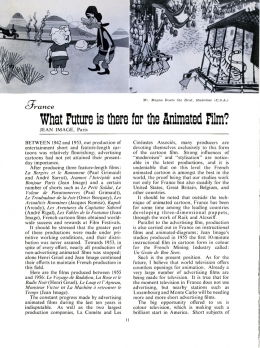
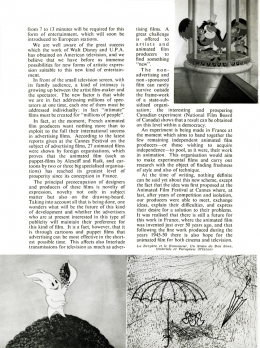
(Click either image to enlarge.)
